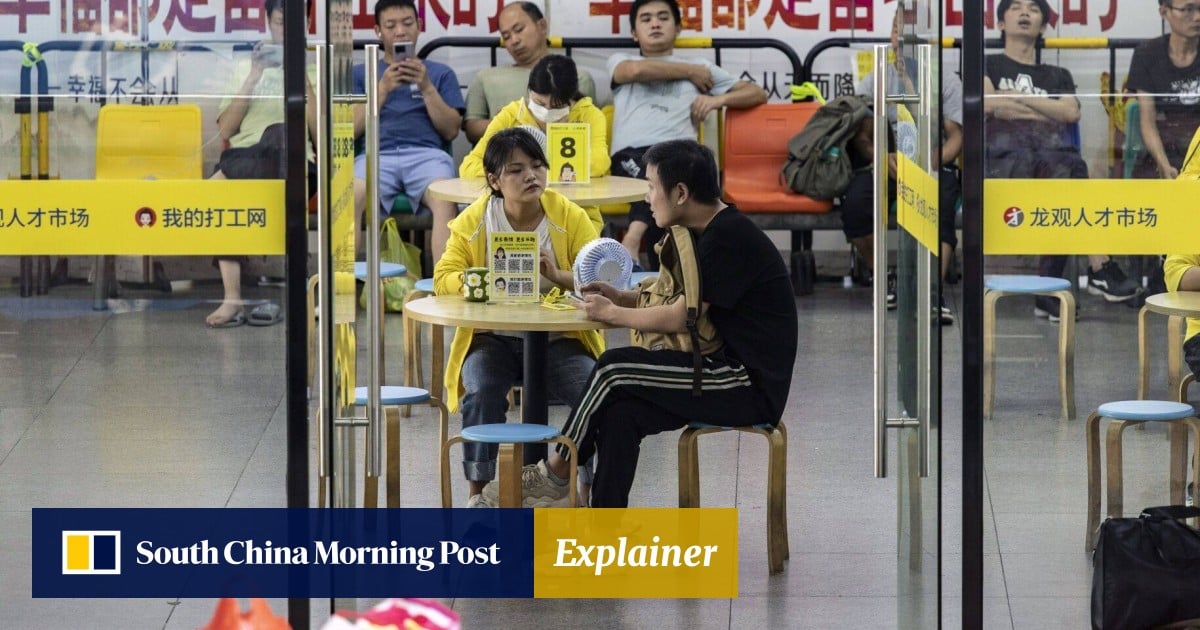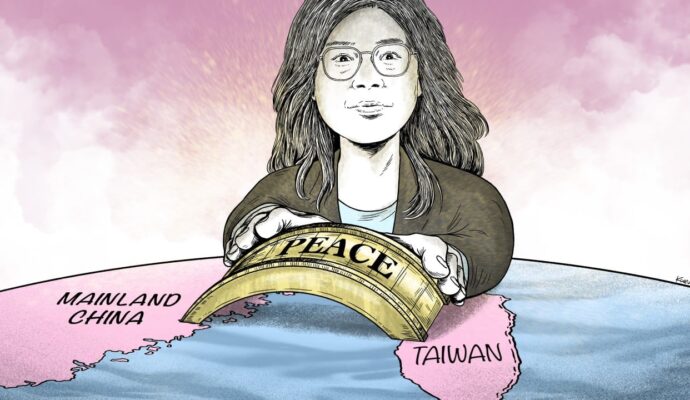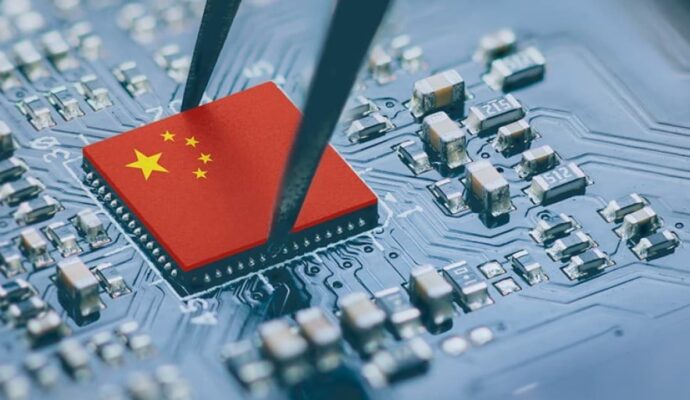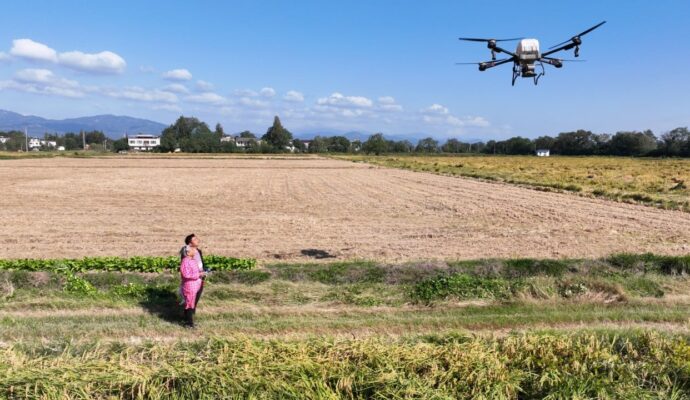
But Fu said that risks will be defused once property-market policies are adjusted.
“The property market has been a huge drag as confidence has seeped out, with lower property investment and lower transaction volumes, suggesting that many of the policy measures aimed at [creating] a soft landing for the property market have yet to restore confidence in the market,” said Heron Lim, an economist at Moody’s Analytics in Singapore.
2. Slowing investment misses expectations
Overall fixed-asset investment in the first seven months of the year grew by 3.4 per cent, but this was lower than the expected rise of 3.9 per cent by Chinese data service provider Wind and slower than the rise of 3.8 per cent in the first half of the year.
China’s hi-tech industries see ‘abrupt cliff-fall decline’ amid US tech war
China’s hi-tech industries see ‘abrupt cliff-fall decline’ amid US tech war
Private investment also fell by 0.5 per cent in the first seven months of the year, compared with a rise of 7.6 per cent seen among state-owned enterprises. In the first half of the year, private investment had fallen by 0.2 per cent.
Advertisement
“The contraction in property investment deepened, but that was offset by a pickup in spending in other sectors. Manufacturing and infrastructure investment were flat,” Capital Economics said.
3. Retail sales ‘perhaps the worst’ in July
Retail sales rose by 2.5 per cent in July, year on year, down from an expected rise of 5.3 per cent by Wind, and down from the 3.1 per cent increase in June.
Capital Economics said that, when accounting for base effects and seasonality, retail sales remained stagnant in month-on-month terms, with the breakdown showing that all sectors were flat last month.
“Perhaps the worst … was the 2.5 per cent year-on-year growth in retail sales. This has declined sharply from an admittedly base-effect-inflated 18.4 per cent year-on-year growth rate in April, as the reopening briefly led to a retail sales surge,” said Robert Carnell, regional head of research for Asia-Pacific at ING.
“Now the idea of a consumer-spending-led recovery is looking very vulnerable.”
4. Factory troubles
Industrial production rose by 3.7 per cent in July from a year earlier, but the reading was lower than the expected 4.6 per cent rise predicted by Wind after the gauge had risen by 4.4 per cent in June.
Advertisement
Factories have not only had to contend with an underwhelming domestic recovery, but also a pullback in foreign demand
“Factories have not only had to contend with an underwhelming domestic recovery, but also a pullback in foreign demand,” added Capital Economics.
Advertisement
“Admittedly, the data suggests there was a slight uptick in export sales among industrial firms in July. But the bigger picture is that it continues to point to a pronounced downturn in external demand, which has yet to be fully reflected in the customs data.”
5. Lack of youth-unemployment figures ‘doesn’t inspire confidence’
The overall surveyed urban jobless rate rose to 5.3 per cent in July, up from 5.2 per cent in June.
Advertisement
But the NBS abruptly stopped publishing monthly jobless-rate breakdowns, including for the 16-24 and 25-59 age groups, citing “the need to improve work on statistical calculation and standards”.
Advertisement
“In recent years, there has been a continuous expansion in the number of students among young people … Their main duty is to study, so whether or not students who are looking for jobs should be included in the calculation of the employment rate should be reviewed,” added NBS spokesman Fu.
“While the urban-unemployment rate remains low compared with much of the past few years, it continued to tick up in July, pointing to some renewed softening in the labour market,” Capital Economics said.
“And a decision to discontinue the youth-unemployment figures just after they hit a record high doesn’t inspire confidence.”
6. Rate cuts not a ‘game-changing outcome’
The central bank also cut the seven-day reverse repo rate by 10 basis points to 1.8 per cent, in a sign that Beijing’s policymakers are willing to do more to support the struggling economy.
This isn’t a game-changing outcome, and so we doubt that market sentiment will dramatically improve just on this
“From a macro perspective, these policy decisions are somewhat helpful. They will help improve the debt-service ability of cash-strapped local governments and property companies,” added Carnell at ING.
“But this isn’t a game-changing outcome, and so we doubt that market sentiment will dramatically improve just on this.”
Capital Economics expects a cut to the loan prime rate on Monday after the PBOC lowered the MLF and seven-day reverse repo rate to new lows.
“But monetary stimulus is of limited use in the current environment and won’t be enough, on its own at least, to put a floor beneath growth,” they added.
Opinion: US-China tech war hinges on who gains semiconductor dominance
Opinion: US-China tech war hinges on who gains semiconductor dominance
7. ‘Rate cut won’t cut it’ amid slowdown
Capital Economics said the data published on Tuesday suggested that the economy was still struggling at the start of the third quarter, and that signs from high-frequency data do not point to a turnaround during the first half of August.
They cited troubles at property developer Country Garden and the state-owned Sino-Ocean, which have sapped confidence among homebuyers and creditors, adding more gloom to the property outlook.
There is a real risk of the economy slipping into a recession unless policy support is ramped up soon
“All the main activity indicators undershot consensus expectations in July, with most either stagnant or barely expanding in month-on-month terms,” said Capital Economics.
“And with financial troubles at developers such as Country Garden likely to weigh on the housing market in the near-term, there is a real risk of the economy slipping into a recession unless policy support is ramped up soon – the rate cut won’t cut it.”
Carnell at ING said that more policy measures will be needed, and that more will certainly be delivered.
“The PBOC has not ended the rate-cutting cycle yet, and there will be further iterations of policy rate cuts along the lines of what we have seen,” he said.
New US investment curbs to have limited impact on China’s targeted tech sectors
New US investment curbs to have limited impact on China’s targeted tech sectors
He expects government stimulus policies to be along the lines of the many supply-side enhancements already being implemented by Beijing.
“Enhancing the efficiency of the private sector will also play a key role, though this and all of the supply-side measures will take considerable time to play out,” Carnell said. “The tiresome chorus clamouring for more stimulus is unlikely to stop in the meantime.
“And we will continue to see weak macro data for the foreseeable future. It is a necessary part of the adjustment and is far preferable to resurrecting the debt-fuelled property model that propelled growth previously.”
Advertisement


